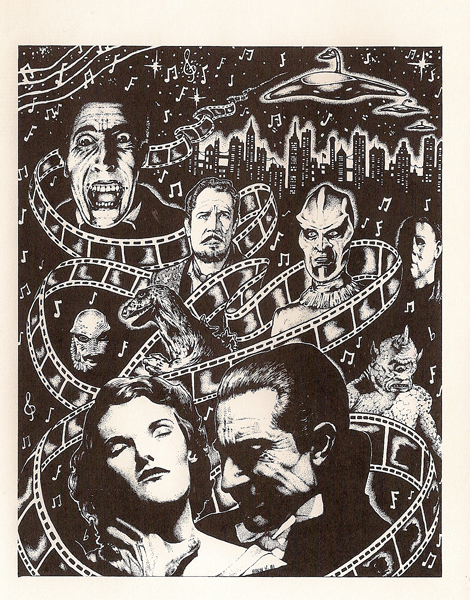An interview with composer Heath Brown
EL MONSTRO DEL MAR’s tagline says it all: Killer Vixens vs The Creature from the Deep. Directed by Stuart Simpson, this 2010 Australian horror thriller starts out as a kind of FASTER PUSSYCAT exploiter by way of Quentin Tarantino as a trio of sexy babes (one of which puts on a pretty good Tura Satana vibe) who massacre guys for fun and frolic, but then turns into a massively Lovecraftian tale as the trio winds up in a dilapidated fishing village in whose coastal waters lurks a tentacled monstrosity from the deep that regularly feeds upon the populace. The film is wildly uneven in tone, but rather enjoyably so. It’s fairly well performed (Kyrie Capri is very good as the Last Virtuous Girl Standing) and weaves a credible enough story line. The opening scene is wonderfully done, beginning in black and white (â la Russ Meyers) and then morphing into full color as the blood begins to spray (â la Quentin Tarantino). For a low budget picture it also exploits some of the coolest puppetry monster fx since THE DEADLY SPAWN, some terrific Tom Savini-esque gore fx, and a wonderful monster assault on the fisherman’s cabin with a great hero moment as the demur granddaughter comes of age with a double barreled shotgun and escorts the squidish creature off the premises. The music is mostly punk rock and blues rock for the killer babes segments, with moments of score composed by Heath Brown that provides effective sonic atmosphere for the spooky and monster attack scenes; plus a splendid deguello for solo trumpet over reverberated castanets that lays down a very cool mood when one of the vixens succumbs to the monster’s attack and is tenderly buried by her friends on the beach.
I tracked down composer Heath Brown in Australia through his web site and arranged an interview about his experienced scoring this charming genre B-movie.

Q: How did you get this assignment?
Heath Brown: After having done my first couple of shorts, I waded through the MySpaceFilm profiles and sent links to my work to all of the Australian filmmakers who’d accessed their profiles in the last 3 months. Stu [Simpson] was the only response I got and he asked me to score a short film of his (PAUSE) for his horror anthology, THE DARK PSYCHOSIS. I was working away on that and various other projects when Stu asked me if I could stop work on PAUSE and instead focus on the score for his new feature, EL MONSTRO DEL MAR. I was still completing my degree in composition at the time, so it was pretty exciting.
 Q: When you first came on board, what kind of music did the filmmakers have in mind, and how did you work with director Stuart Simpson on mapping out where the music should be?
Q: When you first came on board, what kind of music did the filmmakers have in mind, and how did you work with director Stuart Simpson on mapping out where the music should be?
Heath Brown: Stu and I had discussed a number of filmmakers and composers that we liked – Morricone, Herrmann and David Lynch come to mind – and he had temped about half of the film. The rock and roll stuff was already in there, so I got to see that in context before starting work on the scored sections. In terms of spotting, Stu sent me pretty clear notes detailing all of the ins and outs and giving me a general brief in terms of tone. The score took time to complete with my various other commitments, so there was a lot of time for back-and-forthing with drafts, a lot of phone calls and emails. Stu was incredibly supportive and accommodating as I worked on it.
Q: The music (as with the film itself) ranges from B-movie chills to exploitation movie thrills – how did the music need to enhance both the film’s fun and its fear-factor?
Heath Brown: With regard to the music I wrote, Stu and I both agreed that the music had to take itself quite seriously in terms of drama – which hopefully helps the fear factor – while some of the referential stuff, such as the Morricone inspired cues, would also operate on another level, to make the film fun and position it in terms of its influences.
Q: How did your score interact with the rock and roll music of The Stabs used for the “Faster Pussycat” segment with the killer ladies?
Heath Brown: The use of guitars in several cues, I think, helped to weave the various strands of the soundtrack into something that feels quite consistent – for example, recalling the overdriven guitar sound from the earlier music in the Spaghetti Western style cues. Apart from a couple of foreboding underscore moments early in the film, my music doesn’t really kick in until later in the film, which quite intentionally creates a shift in the tone.
Q: Producer Fabian Pisani is also credited with music – what specific music did he provide, and how did you work with him (if you did) to provide a cohesive score?
Heath Brown: Fabian provided most of the bluesy guitar stuff (excluding the cue where Hannah has it out with her grandfather).
Q: Your score is quite varied in texture and tone, from brooding blues guitar pieces to eerie, scraped synth and percussion ambiances, to that gorgeous trumpet de guello for the beach burial of one of the ladies. How did these various styles of music come about – and to what extent are they serving various cinematic/film musical influences that Simpson affectionately brought into the film?
Heath Brown: A lot of it came from the influences I mentioned. The Spaghetti Western-esque cue for the beach burial was pretty explicitly outlined by Stu, so I also drew on that at another point in the film in order to create some consistency. That particular cue – in the cave, where Beretta and Blondie discover Snowball – moves from ambient string and synth textures to Herrmannesque drama to a Western ending, heralding the upcoming revenge mission. I like this cue because it really brings together all the strands in a way that I think really works for the scene. Then there’s the climax, which Stu wanted to be epic, so it really shifts there into overt horror/action music. For that one, I by and large steered away from diatonic material deriving most of the music from chromatic and octatonic fragments.
Q: What was your instrumental pallet for the film – and how much was live players versus synths and samples? How did you achieve such a cool sound for the music (which is allowed to play foreground in many instances in the movie)?
Heath Brown: There are live guitars and trumpet throughout, as well as ambient string techniques which I played myself (with a lot of editing!). Everything else is sample based. Laying in the live instruments, complete with imperfect performances, really helps to give some sections of the score a lift. The climax has all the trumpet parts played live, which particularly helps for the heroic theme near the end, and all of the violin glisses and rips were live as well. In terms of production, a lot of analogue modelling plugins were used to try and take some of the sheen off the sample-based stuff, which can sound a little too clean out of the box, especially for a film like Monstro.
Q: What was most challenging for you in scoring this film?
Heath Brown: As always, having limited resources makes things tricky. When I was first drafting the climax, I could only play back short sections before my computer would give out. Thankfully, I upgraded and was able to finish in relative comfort. Musically, threading together the various elements in a way that worked as a cohesive and coherent score was the biggest challenge. I would sometimes finish one cue, then take that material back to an earlier cue and work it in so it didn’t just sound like a collection of disparate pieces.
Q: As your first feature film score after nearly a dozen short films, how did this project contrast with your experience in the shorter movies?
Heath Brown: I really like the broader time scale. One of the challenges of doing shorts is having to make elegant and meaningful musical statements in very short cues. Having the space to build music over time can seem like a luxury. There’s time to develop and expand on ideas, build more ambitious harmonic structures and work toward dramatic climaxes in a less hurried way.
Q: More and more Australian films and their composers are being recognized internationally – how do you find the state of the art of film music in Australian films, and how do you feel it is being influenced by, and having an influence upon, world cinema music?
Heath Brown: One of the key features of Australian film music, certainly at the end of things where films are being state-funded, is a certain emotional sparseness. The score for SNOWTOWN is a fine example of this, or Paul Kelly’s music for LANTANA. I think this is also true of the films themselves, so it makes sense. There is a lot less emphasis on emotionally guiding audiences through the drama in a tightly knitted way, hitting every possible cue, and more on creating a general emotional ambience. However, with technology enabling a lot more people to create content, I think any national musical identity is being offset by people being able to make films independently and being able to allow all kinds of influences to inform their work. In my work, the musical references I receive vary from Goblin’s music from SUSPIRIA to Steve Jablonsky’s TRANSFORMERS to Coldplay.
Heath Brown won the 2012 Maverick Movie Awards for his score to Glenn Trigg’s sci-fi drama, 41. His earlier score for EL MONSTRO DEL MAR received a Maverick and several festival nominations, and won Best Score at the 2010 Oklahoma Horror Film Festival. His 2010 score for WOUNDED received a best score-short nomination from the Los Angeles “Action On Film” Festival.
For more information on Heath, see his web site at: http://heathbrown.com.au/







